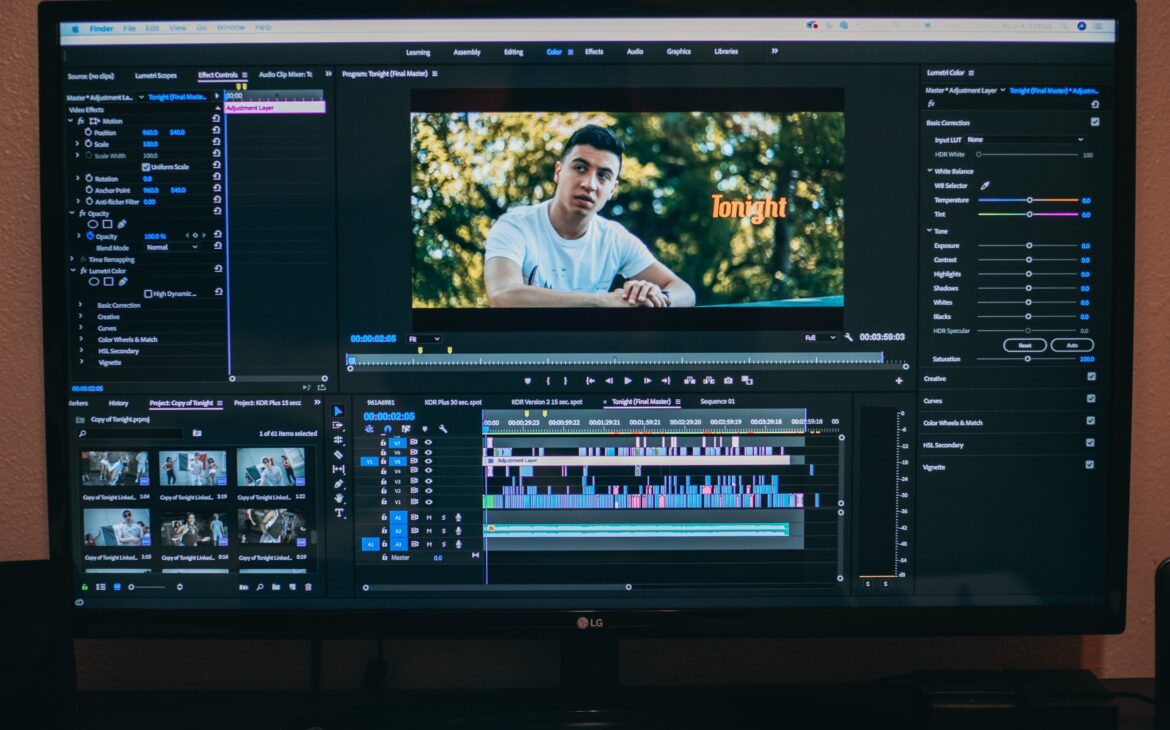Why you need to learn video editing skills in 2025
Video editing has become an indispensable skill in today’s digital age, and students need to acquire these skills as visual storytelling becomes increasingly prevalent across various fields. Whether you are creating a short film, a documentary, or even a class presentation, knowing the essential video editing techniques can greatly enhance the impact of your content.
In this article, we will explore the fundamental concepts and practical tips that every student should know when it comes to video editing. From understanding the editing process to mastering advanced techniques, this guide will provide you with a solid foundation to unleash your creativity and produce captivating videos. Start editing like a pro and take your video projects to the next level.
1. Introduction to Video Editing Techniques
Video editing is a crucial skill that every student should have in their toolkit. Whether you’re working on a school project or creating content for social media, knowing the basics of video editing can take your videos from ordinary to extraordinary. In this article, we’ll cover some essential video editing techniques that will help you bring your vision to life.
Importance of Video Editing Skills
Video editing skills are becoming increasingly important in today’s digital world. With platforms like YouTube and TikTok taking the internet by storm, being able to edit videos is a valuable asset. It allows you to tell a compelling story, capture your audience’s attention, and make your videos more engaging. Plus, having video editing skills can also open up doors for future career opportunities in the media industry. So, whether you’re a budding filmmaker or simply looking to improve your content creation skills, video editing is an essential skill to have.
Overview of Video Editing Software
Now that we understand the importance of video editing, let’s talk about the tools you can use to get started. These software programs offer a wide range of features and functionalities to help you edit your videos seamlessly. Whether you’re just starting or have some experience, there’s video editing software out there that will suit your needs.
2. Essential video editing techniques that every student should know
Before diving into the specific techniques, it’s essential to understand the video editing process as a whole. This process involves several stages, starting from pre-production planning and organization to the final export of the edited video.
Pre-production Planning and Organization
Pre-production is a critical phase where you plan your video, gather all the necessary resources, and organize your ideas. It involves creating a storyboard, writing a script, scouting locations, and ensuring you have all the required footage and assets before you start editing.
Importing and Managing Raw Footage
Once you have your raw footage ready, it’s time to import it into your chosen video editing software. This step involves organizing your clips, labelling them, and creating a system that will help you find specific shots easily.
Timeline and Sequencing
The timeline is where the magic happens. This is where you arrange your clips in the desired order, creating a smooth and coherent flow to your video. You can trim, cut, and rearrange clips on the timeline to tell your story effectively. Sequencing is all about finding the right rhythm and timing to create a visually appealing and engaging video.
3. Basic Video Editing Tools and Functions
Now that you have a good grasp of the video editing process, let’s explore some basic tools and functions that will help you refine your videos.
Trimming and Cutting Clips
Trimming and cutting clips allow you to remove unwanted sections or create seamless transitions between shots. You can trim the beginning or end of a clip to eliminate any unnecessary footage or cut out specific parts within a clip to enhance the pacing of your video.
Arranging and Rearranging Clips
Arranging and rearranging clips on the timeline gives you the flexibility to experiment with different sequencing options. You can easily drag and drop clips to find the most visually appealing and coherent arrangement.
Adding and Manipulating Transitions
Transitions add polish and professionalism to your videos. They are used to smoothly transition between shots, creating a seamless flow and enhancing the visual appeal. You can experiment with various transition effects such as fades, dissolves, or wipes to add that extra flair to your video.

4. Enhancing the Visual Appeal: Color Grading and Correction
Colour grading and correction can significantly enhance the visual appeal of your videos. It allows you to adjust the brightness, contrast, saturation, and overall colour balance to achieve a specific look and feel.
Understanding Color Theory
Before diving into colour grading, it’s essential to understand the basics of colour theory. Different colours evoke different emotions and convey specific messages. By understanding colour theory, you can use colours effectively to enhance the mood and atmosphere of your videos.
Adjusting Brightness, Contrast, and Saturation
Brightness, contrast, and saturation are fundamental adjustments that can make a tremendous difference in the overall look of your video. You can control the exposure, highlight shadows, and make colours pop by adjusting these settings.
Applying Filters and Effects
Filters and effects offer endless creative possibilities. You can apply various filters to give your video a different visual style or add effects like blurs, vignettes, or overlays to create a specific mood or atmosphere.
Now that you have a better understanding of these essential video editing techniques, it’s time to grab your footage and start experimenting. Remember, practice makes perfect, so keep editing, have fun, and let your creativity shine through!
5. Mastering Transitions, Effects, and Filters
Transitioning between clips, adding effects, and applying filters can take your video editing skills to the next level. Here’s what you need to know:
Different Types of Transitions
Transitions are essential for creating smooth and seamless video edits. From simple cuts to fancy wipes and fades, there are various types of transitions you can use to enhance your storytelling. Experiment with different transitions to find the ones that suit your video’s mood and style.
Adding and Customizing Video Effects
Video effects allow you to enhance the visual appeal of your footage. Whether you want to create a vintage look or add a cool glitch effect, video editing software provides a range of effects you can apply. Don’t be afraid to experiment and customize the effects to make your videos stand out.
Utilizing Filters for Creative Visuals
Filters can be used to alter the colour and tone of your footage, giving it a unique and artistic look. From basic colour correction to creative grading, filters allow you to manipulate the visual elements of your video. Play around with different filters to achieve the desired aesthetics and evoke specific emotions.
6. Crafting a Compelling Story: Narrative Techniques in Video Editing
Here are some narrative techniques to help you create engaging videos:
Establishing a Storytelling Structure
Every video should have a clear structure that guides the viewer through the narrative. Consider using techniques like the three-act structure or creating a consistent rhythm to keep your audience engaged from start to finish.
Creating Effective Montages
Montages can help condense time and convey information quickly. Whether you’re showcasing a character’s transformation or highlighting a series of events, crafting a well-paced and visually captivating montage can make your videos more dynamic.
Using B-roll and Cutaways
B-roll footage and cutaways are supplementary shots that provide context or add visual interest to your main footage. Using B-roll and cutaways can help break up monotonous visuals and make your video more engaging. Be selective and choose shots that enhance the story or emphasize key points.
7. Audio Editing and Sound Design Tips
Here are some tips to improve your audio editing and sound design skills:
Importance of Sound in Video Editing
Sound can evoke emotions, set the mood, and enhance the overall viewing experience. Pay attention to audio quality, ensure clear dialogue, and use sound effects strategically to immerse your audience in the video’s world.
Adjusting Audio Levels and Balancing
Ensure that the audio levels are consistent throughout your video. Adjust volumes, eliminate background noise, and balance multiple audio tracks to ensure a pleasant and professional-sounding video.
Adding Sound Effects and Background Music
Sound effects and background music can elevate the atmosphere of your video. Whether it’s adding suspenseful sounds or incorporating a catchy tune, carefully select and place audio elements to enhance your storytelling and engage your viewers.

8. Advanced Techniques and Tips for Efficient Editing
Once you have a solid understanding of the basics, here are some advanced techniques and tips to increase your efficiency and streamline your editing process:
Keyboard Shortcuts and Time-saving Tips
Familiarize yourself with commonly used shortcuts in your editing software and discover other time-saving tricks like batch editing or using templates to help you work more efficiently.
Multi-camera Editing Techniques
If you’re working with footage from multiple cameras, mastering multi-camera editing techniques can save you time and give your videos a professional touch. Syncing angles, switching between shots, and creating dynamic sequences can elevate your editing skills and make your videos more engaging.
Collaboration and Sharing Projects
Collaborating with others or sharing your projects with clients or classmates often requires efficient file management and communication. Familiarize yourself with project sharing and collaboration features in your editing software, and explore cloud-based solutions for easier teamwork and seamless project sharing.
Conclusion
Remember, video editing is an art form that combines technical skills with creative storytelling. Embrace the learning process, experiment with different techniques, and always strive to improve your craft. Happy editing! In conclusion, mastering video editing techniques can empower students to effectively communicate their ideas, stories, and messages through the medium of video. By understanding the editing process, utilizing basic tools, enhancing visual appeal, and incorporating narrative techniques, students can create compelling and professional-looking videos. Additionally, honing audio editing skills and exploring advanced techniques can elevate their video editing prowess further. So, embrace the power of video editing and let your creativity shine as you embark on your journey to become a proficient video editor. Happy editing!

FAQ
1. What software do I need for video editing?
There are several video editing software options available, ranging from free to paid ones. Choose the software that suits your needs and budget, and invest time in familiarizing yourself with its features.
2. Can I learn video editing on my own?
Absolutely! With the abundance of online tutorials, courses, and resources, learning video editing on your own is entirely feasible. Dedicate time to practice and experiment with different tools and techniques. Additionally, seeking feedback from others, participating in online communities, and analyzing well-edited videos can greatly enhance your skills.
3. How important is audio editing in video production?
Audio plays a vital role in video production. Poorly edited or unbalanced audio can negatively impact the viewer’s experience. Pay attention to audio levels, remove background noise, and use sound effects and music strategically to enhance the overall quality of your video.
Thank you for reading 🙂
If you want to build your website at an affordable price contact: www.nextr.in
Read this: How To Become A Web Developer?


















